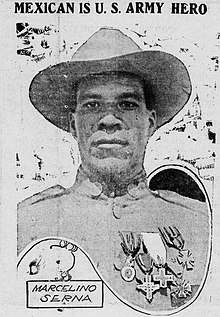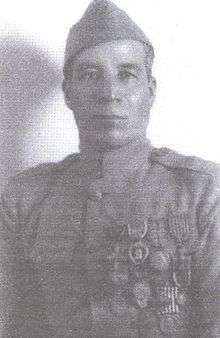Marcelino Serna
Private Marcelino Serna (April 26, 1896 – February 29, 1992) was a Mexican immigrant who lived in El Paso, Texas.[1] He became one of the most decorated soldiers from Texas in World War I. Serna was the first Hispanic to be awarded the Distinguished Service Cross.
Marcelino Serna | |
|---|---|
 Private Marcelino Serna, first Hispanic to be awarded the Distinguished Service Cross | |
| Born | April 26, 1896 Chihuahua, Chih., Mexico |
| Died | February 29, 1992 (aged 95) El Paso, Texas |
| Allegiance | United States |
| Service/ | |
| Years of service | 1917-1919 |
| Rank | Private |
| Unit | Company B, 355th Infantry of the 89th Division |
| Battles/wars | World War I *Lucey Sector *Puvenelle Sector *Meuse-Argonne *Battle of Saint-Mihiel *Ennezin |
| Awards | Distinguished Service Cross Purple Heart with Oak Leaf Cluster French Croix de Guerre with Palm (2x) War Merit Cross (Italy) |
Early years
Serna was born in the City of Chihuahua, in the Mexican state of Chihuahua, to a poor family. In 1916, when he was 20 years old, Serna decided to enter the United States, by crossing the Rio Grande and going to El Paso, Texas in search of a job and better way of life. Serna did not know how to speak English and he was only able to find low-paying jobs. He soon found himself working as a farm hand in a sugar beet field in Denver, Colorado.[2]
The United States declared war on Germany on April 6, 1917. Serna was with a group of men in Denver, when he was picked up by federal officials. He faced the possibility of being deported, but before that could happen, he volunteered to serve in the Army.[2]
World War I
After his basic training Serna was sent overseas and assigned to Company B, 355th Infantry of the 89th Division. When the Army realized that he was a Mexican national, he was offered a discharge. Serna, however refused and chose to stay with his new friends.[3]
Serna's unit was ordered to begin an advance towards the Meuse River and Argonne Forest in France. When his unit arrived at Saint-Mihiel, they encountered a German machine gunner who killed 12 soldiers. Serna crawled up to the machine gunner's left flank. Even though his helmet was hit twice with bullets, Serna was able to get close enough to throw four grenades into the nest. Eight Germans surrendered and the rest in the nest were dead.[4]
On September 12, 1918, Serna's unit was engaged in combat inside the Meuse-Argonne region when he spotted a German sniper and wounded him with his Enfield rifle. Serna followed the wounded soldier to a trench. He threw three grenades into the trench which resulted in the death of 26 enemy soldiers and the capture of 24 prisoners.[2]
Serna was wounded in both of his legs by sniper fire, four days before the Armistice. During his recovery, General John J. Pershing, Commander-in-Chief of the American Expeditionary Forces, pinned on his chest the Distinguished Service Cross, the second highest military decoration of the United States Army to the Medal of Honor. Serna was told by an officer that "Buck Privates" were not eligible for the Medal of Honor, and that he did not know enough English to be promoted.[5] The officer in question was wrong because Private David B. Barkley who also served in the 89th Division, was awarded the Medal of Honor for his actions. It so happens that years later it was discovered that Barkley was Hispanic, thus the only Hispanic recipient of the Medal of Honor in World War I.[6] Field Marshal Ferdinand Foch, Supreme Commander of the Allied troops, awarded Serna the French Croix de Guerre for bravery.
Distinguished Service Cross Citation

"The Distinguished Service Cross is presented to Marcelino Serna, Private, U.S. Army, for extraordinary heroism in action near Flirey, France, September 12, 1918. Private Serna displayed exceptional coolness and courage in single handed charging and capturing 24 Germans." General Orders No. 27, W.D., 1919
Home Town: Fort Morgan, CO.[7]Later years

Serna returned to the U.S. as the most decorated soldier from Texas and was discharged at Camp Bowie, Texas in May 1919.[8] In 1924, Serna became a United States citizen and soon after he married and settled down in El Paso, Texas. He went to work at the Peyton Packing Company. In 1960, he retired as a plumber from William Beaumont Hospital. On February 29, 1992, Marcelino Serna died at the age of 95. He was buried with full military honors at Fort Bliss National Cemetery, of El Paso, Texas.
On January 17, 1995, Congressman Ronald D'Emory Coleman introduced legislation before the House of Representatives that requested that Serna be awarded the Medal of Honor posthumously, to no avail.[9]
In 2007 at the 78th Annual LULAC (League of United Latin American Citizens) Convention, the following resolution was adopted by the National Assembly: Congressional Medal of Honor Recommendation for Guy Louis Gabaldon, Rafael Peralta and Marcelino Serna.[10]
On September 29, 2016, the United States designated the Customs and Border Protection Port of Entry located at 1400 Lower Island Road in Tornillo, Texas, as the "Marcelino Serna Port of Entry."[11]
Awards and decorations
Among Serna's many military decorations are the following:[note 1]
| Distinguished Service Cross | |
| Purple Heart with oak leaf cluster | |
| World War I Victory Medal | |
| French Croix de Guerre with Palm (2) (France) | |
| French Médaille militaire (France) | |
| Croce al Merito di Guerra (Italy) | |
| French Commemorative Medal (France) | |
| 1914–1918 Inter-Allied Victory medal (France) (France) | |
| St. Mihiel Medal (France) | |
| Verdun Medal (France) |
See also
| Wikimedia Commons has media related to Marcelino Serna. |
- Private David Bennes Barkley who also served in the 89th Division and was the only Hispanic recipient of the Medal of Honor in World War I.
Notes
- According to some cited references, such as Borderlands, Serna was awarded the "British Medal of Honor". There is not, nor has ever been, such a decoration.
References
- Rudy Reyes (2017-03-14), Marcelino Serna WW1 Texas Hero, retrieved 2017-07-30
- Marcelino Serna
- "Hispanic hero:Marcelino Serna" (PDF). Archived from the original (PDF) on 2018-02-19. Retrieved 2012-06-28.
- Hispanic Military History Archived May 11, 2011, at the Wayback Machine
- Hispanics in America's Defense By DIANE Publishing Company. 1918-09-12. Retrieved 2012-06-28.
- D. López. "Saving Private Aztlan: Preserving the History of Latino Service in Wartime". Diálogo Magazine. Archived from the original on 2006-07-19. Retrieved 2006-07-14.
- Serna DSC Citation Archived August 29, 2006, at the Wayback Machine
- Armistice and After Archived 2008-07-20 at the Wayback Machine
- "Sernas of the World". Sernasoftheworld.blogspot.com. Retrieved 2012-06-28.
- LULAC-2007 Archived May 16, 2008, at the Wayback Machine
- "Text of H.R. 5252 (114th): To designate the United States Customs and Border Protection Port of Entry located ... (Passed Congress/Enrolled Bill version) - GovTrack.us". GovTrack.us. Retrieved 2017-07-30.
Further reading
- Hispanics in America's Defense Publisher: Diane Pub Co (August 1989); Language: English; ISBN 0-7881-4722-6; ISBN 978-0-7881-4722-7
- Hispanics in America's Defense: by Department of Defense; Publisher: U.S. Government Printing Office (1990); ASIN: B000GWLOMU